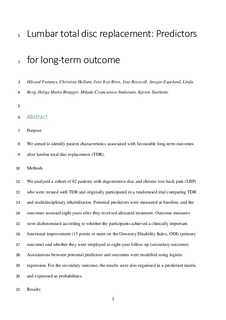| dc.contributor.author | Furunes, Håvard | |
| dc.contributor.author | Hellum, Christian | |
| dc.contributor.author | Brox, Jens Ivar | |
| dc.contributor.author | Rossvoll, Ivar | |
| dc.contributor.author | Espeland, Ansgar | |
| dc.contributor.author | Berg, Linda | |
| dc.contributor.author | Brøgger, Helga Maria | |
| dc.contributor.author | Småstuen, Milada C | |
| dc.contributor.author | Storheim, Kjersti | |
| dc.date.accessioned | 2018-01-18T13:17:14Z | |
| dc.date.available | 2018-01-18T13:17:14Z | |
| dc.date.created | 2017-12-07T15:38:10Z | |
| dc.date.issued | 2017 | |
| dc.identifier.citation | European spine journal. 2017, . | nb_NO |
| dc.identifier.issn | 0940-6719 | |
| dc.identifier.uri | http://hdl.handle.net/11250/2478166 | |
| dc.description.abstract | Purpose
We aimed to identify patient characteristics associated with favourable long-term outcomes after lumbar total disc replacement (TDR).
Methods
We analysed a cohort of 82 patients with degenerative disc and chronic low back pain (LBP) who were treated with TDR and originally participated in a randomised trial comparing TDR and multidisciplinary rehabilitation. Potential predictors were measured at baseline, and the outcomes assessed 8 years after they received allocated treatment. Outcome measures were dichotomised according to whether the participants achieved a clinically important functional improvement (15 points or more on the Oswestry Disability Index, ODI) (primary outcome) and whether they were employed at 8-year follow-up (secondary outcome). Associations between potential predictors and outcomes were modelled using logistic regression. For the secondary outcome, the results were also organised in a prediction matrix and expressed as probabilities.
Results
For 71 patients treated with TDR according to protocol, the follow-up time was 8 years. For a subgroup of 11 patients randomised to rehabilitation who crossed over and received TDR, the median postoperative follow-up time was 72 (range 41–88) months. Of all assessed baseline variables, only presence of Modic changes (type 1 and/or 2) was statistically significantly associated with an improvement of ≥ 15 ODI points. The probability of employment at 8-year follow-up was 1% for patients with ≥ 1 year of sick leave, comorbidity, ODI ≥ 50 and ≤ 9 years of education prior to treatment, and 87% for patients with < 1 year of sick leave, no comorbidity, ODI < 50 and higher education.
Conclusions
Patients with Modic changes prior to the TDR surgery were more likely to report a clinically important functional improvement at long-term follow-up. Comorbidity, low level of education, long-term sick leave and high ODI score at baseline were associated with unemployment at long-term follow-up. | nb_NO |
| dc.language.iso | eng | nb_NO |
| dc.publisher | Springer Verlag | nb_NO |
| dc.title | Lumbar total disc replacement: predictors for long-term outcome | nb_NO |
| dc.type | Journal article | nb_NO |
| dc.type | Peer reviewed | nb_NO |
| dc.description.version | acceptedVersion | nb_NO |
| dc.source.pagenumber | 1-10 | nb_NO |
| dc.source.journal | European spine journal | nb_NO |
| dc.identifier.doi | 10.1007/s00586-017-5375-1 | |
| dc.identifier.cristin | 1524432 | |
| dc.description.localcode | This is a post-peer-review, pre-copyedit version of an article published in [European Spine Journal]. Locked until 4.11.2018 due to copyright restrictions. The final authenticated version is available online at: https://link.springer.com/article/10.1007%2Fs00586-017-5375-1 | nb_NO |
| cristin.unitcode | 194,65,30,0 | |
| cristin.unitname | Institutt for nevromedisin og bevegelsesvitenskap | |
| cristin.ispublished | true | |
| cristin.fulltext | original | |
| cristin.qualitycode | 1 | |
